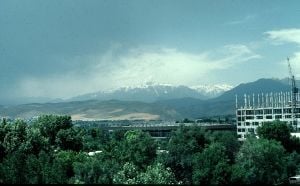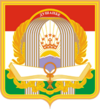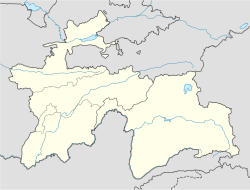Difference between revisions of "Dushanbe" - New World Encyclopedia
Mike Butler (talk | contribs) |
Mike Butler (talk | contribs) |
||
| Line 54: | Line 54: | ||
==History== | ==History== | ||
| − | Although archaeological remnants dating to the | + | [[Image:Somoni monument.JPG|thumb|left|250px|Monument of [[Ismail Samani]] in Dushanbe]] |
| + | Although archaeological remnants dating to the fifth century b.c.e. have been discovered in the area, there is little to suggest that Dushanbe was more than a small village until around 80 years ago. In 1920, the last [[Emirate of Bukhara|Emir of Bukhara]] briefly took refuge in Dushanbe after being overthrown by the [[Bolshevik]] revolution. He fled to [[Afghanistan]] after the [[Red Army]] conquered the area the next year. | ||
| + | |||
| + | With the Red Army victory and coming of the railroad from 1929, the city became the capital of the [[Tajik Soviet Socialist Republic]]. Up until this time the city was named "Dyushambe", but in 1929 it was renamed "Stalinabad", after [[Joseph Stalin]]; as part of [[Nikita Khrushchev]]'s [[History of the Soviet Union (1953-1985)|de-Stalinization]] initiative, the city was renamed "Dushanbe" in 1961. | ||
| − | |||
The Soviets transformed the area into a centre for cotton and silk production, and relocated tens of thousands of people to the city from around the Soviet Union. The population also increased with thousands of ethnic Tajiks migrating to Tajikistan following the transfer of [[Bukhara]] and [[Samarkand]] to the [[Uzbek SSR]]. A peaceful and relatively prosperous city under Soviet rule, Dushanbe was home to a university and the [[Tajik Academy of Sciences]]. Severe rioting occurred in 1990, after it was rumored that [[Moscow]] planned to relocate tens of thousands of [[Armenia]]n refugees to Tajikistan, which spurred local nationalist sentiment. | The Soviets transformed the area into a centre for cotton and silk production, and relocated tens of thousands of people to the city from around the Soviet Union. The population also increased with thousands of ethnic Tajiks migrating to Tajikistan following the transfer of [[Bukhara]] and [[Samarkand]] to the [[Uzbek SSR]]. A peaceful and relatively prosperous city under Soviet rule, Dushanbe was home to a university and the [[Tajik Academy of Sciences]]. Severe rioting occurred in 1990, after it was rumored that [[Moscow]] planned to relocate tens of thousands of [[Armenia]]n refugees to Tajikistan, which spurred local nationalist sentiment. | ||
The city was badly damaged as a result of the [[Civil War in Tajikistan]] (1992–1997) that sprang up in the nation shortly after its independence. | The city was badly damaged as a result of the [[Civil War in Tajikistan]] (1992–1997) that sprang up in the nation shortly after its independence. | ||
| + | |||
However resurgences in the Tajik economy have transformed Dushanbe into a rapidly growing commercial, cultural and industrial center. Many multi-story apartment and office buildings were constructed and the city was beautified during this period. Monuments and statues commemorating the city's [[Persian Empire|Persian]] and [[Iran]]ian past were erected. | However resurgences in the Tajik economy have transformed Dushanbe into a rapidly growing commercial, cultural and industrial center. Many multi-story apartment and office buildings were constructed and the city was beautified during this period. Monuments and statues commemorating the city's [[Persian Empire|Persian]] and [[Iran]]ian past were erected. | ||
Revision as of 05:18, 20 September 2008
| Dushanbe | |||
| Looking north across the city | |||
|
|||
| Location of Dushanbe in Tajikistan | |||
| Coordinates: {{#invoke:Coordinates|coord}}{{#coordinates:38|32|12|N|68|46|48|E|type:city | |||
|---|---|---|---|
| name= }} | |||
| Country | Tajikistan | ||
| Government | |||
| - Mayor | Mahmadsaid Ubaydulloyev | ||
| Area | |||
| - Total | 100 km² (38.6 sq mi) | ||
| Elevation | 706 m (2,316 ft) | ||
| Population (2006)[1] | |||
| - Total | 661,100 | ||
| - Density | 5,051/km² (13,082/sq mi) | ||
| Time zone | GMT (UTC+5) | ||
| - Summer (DST) | GMT (UTC+5) | ||
| Website: www.dushanbe.tj | |||
Dushanbe (Tajik: Душанбе, Dushanbe; formerly Dyushambe or Stalinabad), population 661,100 people (2006 census), is the capital and largest city of Tajikistan.
Geography
The name is derived from the Persian word for "Monday" (du two + shamba or shanbe day, lit. "day two",دوشنبه) and refers to the fact that it was a popular Monday marketplace.
Situated on the confluence of two rivers, Varzob and Kafernihon, Dushanbe's location was once famous for its market on Mondays.
Elevation
Dushanbe's climate is damper than other Central Asian capitals, with an average annual rainfall over well over 20 inches (500mm) but is still highly continental and has the hot, dry summers typical of the region. Winters are not as cold as further north owing to the shielding of the city by mountain from extremely cold air from Siberia. The average maximum daytime temperature in January of 44.6°F (7°C), rising to an average maximum of around 95°F (35°C) in July.
Rivers and canals Size – land area, size comparison Environmental issues Districts
History
Although archaeological remnants dating to the fifth century B.C.E. have been discovered in the area, there is little to suggest that Dushanbe was more than a small village until around 80 years ago. In 1920, the last Emir of Bukhara briefly took refuge in Dushanbe after being overthrown by the Bolshevik revolution. He fled to Afghanistan after the Red Army conquered the area the next year.
With the Red Army victory and coming of the railroad from 1929, the city became the capital of the Tajik Soviet Socialist Republic. Up until this time the city was named "Dyushambe", but in 1929 it was renamed "Stalinabad", after Joseph Stalin; as part of Nikita Khrushchev's de-Stalinization initiative, the city was renamed "Dushanbe" in 1961.
The Soviets transformed the area into a centre for cotton and silk production, and relocated tens of thousands of people to the city from around the Soviet Union. The population also increased with thousands of ethnic Tajiks migrating to Tajikistan following the transfer of Bukhara and Samarkand to the Uzbek SSR. A peaceful and relatively prosperous city under Soviet rule, Dushanbe was home to a university and the Tajik Academy of Sciences. Severe rioting occurred in 1990, after it was rumored that Moscow planned to relocate tens of thousands of Armenian refugees to Tajikistan, which spurred local nationalist sentiment.
The city was badly damaged as a result of the Civil War in Tajikistan (1992–1997) that sprang up in the nation shortly after its independence.
However resurgences in the Tajik economy have transformed Dushanbe into a rapidly growing commercial, cultural and industrial center. Many multi-story apartment and office buildings were constructed and the city was beautified during this period. Monuments and statues commemorating the city's Persian and Iranian past were erected.
Government
Economy
Overview – Any specialization: For instance, is a manufactured product is associated with particular cities a. Milwaukee—cheese and beer b. Los Angeles—entertainment industry c. Sheffield—coal d. top 20 cities in the U.S. are highly specialized
Per capita GDP, rank Financial and business services sector Tourism Manufacturing Transport: Road, rail, air, sea
Coal, lead, and arsenic are mined nearby in the cities of Nurek and Kulob allowing for the industrialization of Dushanbe. In the city of Nurek, at the Nurek Dam, the world's highest hydroelectric station, provides 95% of Tajikistan's electricity, and another dam, the Roghun Dam, is planned on the Vakhsh River. A leading cotton textile center, Dushanbe also produces silk, machinery, electrical appliances, clothing, leather goods, tractor parts, and foodstuffs. The city of Dushanbe is now home to a number of modern telecommunications, aeronautic and other business corporations adding vitality to its economy. Tourism and ecotourism, to the beautiful natural scenery throughout the Dushanbe area is now a component of the burgeoning service industry, which includes world-class shopping centers, cafes, restaurants and hotels in the city's economic center. Cultural and Ethnic Museums and Theatres add a cultural element to the economy.
Demographics
Population, population rank Race/ethnicity - historical background of ethnic groups Language Religion Colleges and universities
Of interest
- Dushanbe Airport
- Haji Yakoub Mosque
- Museum of Ethnography
- Tajikistan National Museum (Tajik Unified Museum)
- The National Museum of Antiquities of Tajikistan
- Vahdat Palace
- Dushanbe Zoo
- Botanical Garden
- Dushanbe Opera
- Dushanbe Circus
- Gurminj Museum of Musical Instruments (Gurminj Museum)
See also
- Farkhor Air Base
- Symphonic Orchestra of Dushanbe
- Kabul, Afghanistan
- School for Deaf and Mute (Dushanbe)
Notes
- ↑ Capital city with population by country. Retrieved 2007-01-25.
External links
- Encyclopaedia Britannica Dushanbe Retrieved September 20, 2008.
- World Fact Book 2008 Tajikistan Retrieved September 20, 2008.
- Dushanbe pictures through eyes of westerner
- Dushanbe street map
- Encyclopedia Iranica article on Dushanbe
- Tajikistan map
- Dushanbe on wikimapia
- Tajik Web Gateway
- Dushanbe City Coat of Arms
- Boulder-Dushanbe Sister Cities
- 1:500,000 topo map of Dushanbe area
Credits
New World Encyclopedia writers and editors rewrote and completed the Wikipedia article in accordance with New World Encyclopedia standards. This article abides by terms of the Creative Commons CC-by-sa 3.0 License (CC-by-sa), which may be used and disseminated with proper attribution. Credit is due under the terms of this license that can reference both the New World Encyclopedia contributors and the selfless volunteer contributors of the Wikimedia Foundation. To cite this article click here for a list of acceptable citing formats.The history of earlier contributions by wikipedians is accessible to researchers here:
The history of this article since it was imported to New World Encyclopedia:
Note: Some restrictions may apply to use of individual images which are separately licensed.



